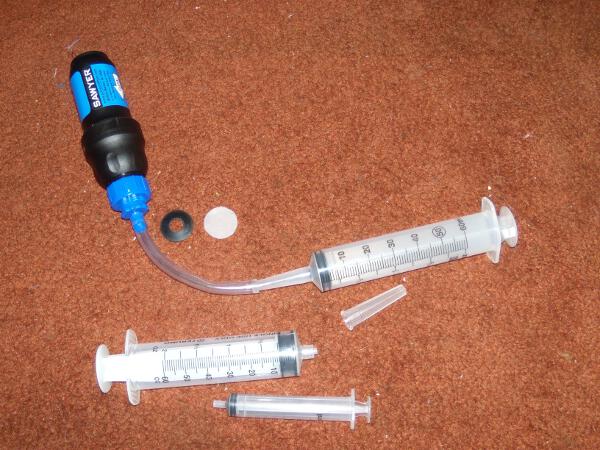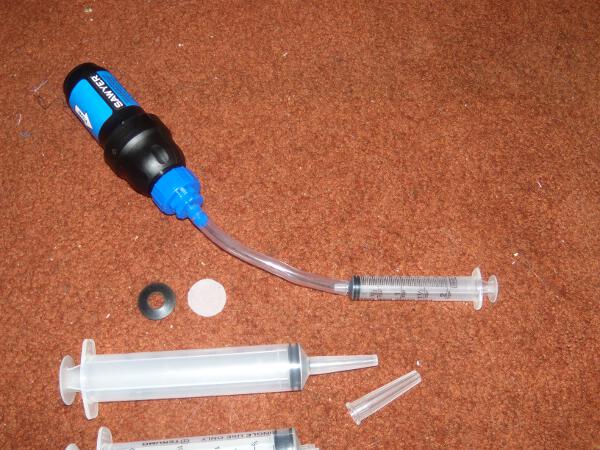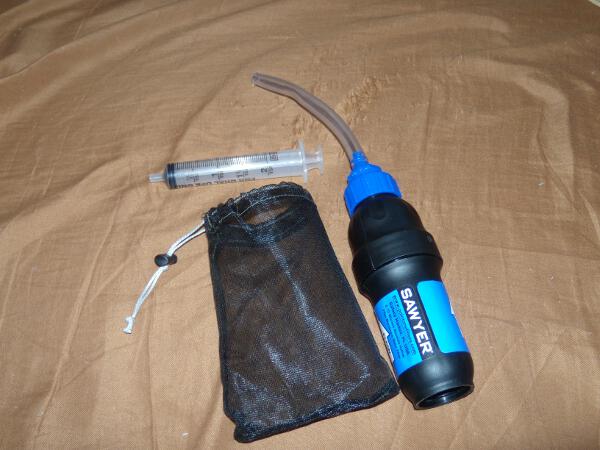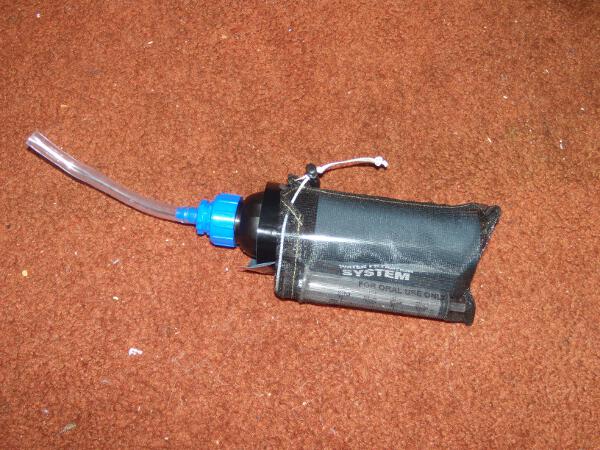Sawyer Squeeze Filter Modifications Part 2 – Cleaning Syringes and Storage Bag
Posted: September 12th, 2012 by: h2
The Sawyer Point One Squeeze filter (0.1 micron version) has grown to be one of my favorite pieces of gear.
There are two pages of modifications:
- Simple Modifications for Sawyer Squeeze Filter
- Sawyer Squeeze Filter Cleaning – Syringe Options (this page) Update 2013-06-30: Do not use smaller syringes than 60ml/2oz, this can form channeling over time.
Ok, so you’ve done Part 1. This now lets you do part 2, and fixes what is in my opinion the single weakest part of the Sawyer Squeeze design, the backflushing syringe they include. First, the one they provide is really big. Second, it doesn’t seat nicely into the clean end of Sawyer Squeeze, you have to sort of press it on.

However, have no fear, that’s an easy problem to solve.
Changing Irrigation Syringes – On Trail And Home Use
[Update: do not follow this suggestion, I have reconsidered this question and this is a bad idea, use either 60ml syringe for maximum 2oz flow for about 1 second, or use nothing. Use of smaller syringes can lead to filter tube channeling, which is not reparable). The long tip 60ml however works very well, and is highly recommended.
I had a brain storm (too bad it was wrong, see note above), and realized I should check for smaller or better fitting irrigation syringes. That’s what that big thing is, with the plunger. After discovering that big pharmacy chains were totally useless and didn’t carry such things, I went to an old local store, Johnson’s Medical Supply in Berkeley, if you live in a larger city, you almost certainly have a true medical supply store. NOT, repeat, a junk filled big box chain place, it’s a store dedicated to only medical supply products.
So I went, and, lo and behold, I found two syringes, one absolutely perfect for home cleaning, or bounce box storage and in town resupply type use, the other a bit too small, but I think it will be sufficient for on trail cleaning. And boy is the small one light. I think a 15 or 20 ml version would be much better, but they didn’t have that size, so this is ok. Note that the small unit is 1/6 the size of the big one, so you need to do a lot more refills to get it clean. (Do not do this, it’s a bad idea, use only 60 ml syringes).
Pictures tell the story fine here, so here we go:

Here we have the filter and tube mod from Part 1, the small irrigation syringe, 10 ml, and the bigger one, notice how it has the tip? That tip will fit into the tube, making a snug and clean fitting. The 10 ml syringe can just be pushed against the tube, which is bigger than the syringe end on the inside, but it’s soft material so it fits well.

There’s the big one, with its tip stuck into the tube. Works perfectly.
You can see the old one that Sawyer included, that tip doesn’t fit into anything, and it’s hard to actually understand what Sawyer was thinking when they picked that unit.

And there’s the little unit. Takes 6 refills/plunges to equal one big one, but my feeling is because you don’t get a continuous stream of backflushing pressure, it’s probably not wise to only use the little syringe over time. (update: not only is it not wise, it’s a downright bad idea because it can lead to channeling inside the filter that can never be corrected, so use either the 60ml or nothing if you want your filter to last).
I did, by the way, try using two screw on ends with hoses, to try to use a bladder bag to backflush, but I couldn’t generate enough pressure, and it felt like I’d probably end up bursting the bag over time if I tried it, and it really didn’t get much more than a dribble when backflushing. You will come across people who suggest this in an attempt to save weight, but I strongly urge you to NOT follow that advice if you want your filter to last over time.
Make a Small Mesh Storage Bag
Now that’s it’s all done, I wanted a way to store it all, so I could put it in outside pockets without worrying about losing the prefilter elements, and also having the syringe there for easy access. I’ll usually store this in an outside pocket of my backpack, unless it’s going to be below freezing, then it has to go inside, and I’ll also include a small plastic bag to keep things dry inside the pack.

There’s the nylon mesh stuff sack, this one is made out of 0.9 ounce per yard nylon noseeum netting, you can use 0.7 oz yd. The stuff sack weighs 2.5 grams. Could be just a plastic bag, but this is more permanent, and doesn’t weigh much more than a plastic bag either.

And here it is with the Sawyer Squeeze cut down 16 ounce bag water scoop rolled around the filter inside the mesh bag, if you decided you want to do it that way.
And there you have it, some very easy and cheap mods for your Sawyer Squeeze filter.
Tips
Never let the Sawyer freeze, if you do, it has to be discarded to be safe. Sleep with it in your sleeping bag if it’s going to get cold at night.
Take the prefilter element out when backflushing it, you don’t want to trap gunk behind it, or accidentally pop the prefilter out and have to find it somewhere on the ground.
Carry a spare prefilter screen, it doesn’t weigh anything and you already have bought the coffee filter anyway.
You updated part 1 saying Sawyer’s squeeze bags for 2013 are stronger than their predecessors. Have you tried using one of these in place of a syringe with better results?
Also, removing the washer and pre-filter screen every time you back-flush, then replacing it, is cumbersome, at least that’s what I found when replacing the original washer after I removed it to examine the filter. What if you simply screwed in the cut off business end of a drink bottle to hold the washer down while back flushing? I can’t imagine anything coming from inside the tubules will be greater than the 15-20 microns of the coffee filter and the back-flush water is getting filtered to 0.1 microns, anything that size or smaller should easily pass through the screen. Besides, this would help clear the sediment from the outer side of the coffee filter, wouldn’t it?
Also, I read typical use of this filter (without a pre-filter) results in the eventual PERMANENT halving of the flow rate performance. Have you found that this Ace Hardware coffee filter protects the performance of the Sawyer filter?
Lastly, do you find the Ace Hardware filter when free of debris noticeably reduces the squeeze filter’s flow rate, particularly when used in gravity mode, or is it about the same?
Thank you for this informative article. Looking forward to your reply.
I haven’t had the opportunity to have used this stuff as much as I had hoped since I wrote that article, but let me answer from what I have seen so far:
1: You can’t use a bag instead of a syringe, the pressure is not great enough to backflush out the gunk. Sawyer says inadequate backflushing results in the filter slowly failing over time, or losing the outer ring of filter material to clogging as the course of least resistance is developed over time and improper backflushing. You can by the way find 20 ml irrigation syringes, I’m not sure if those are big enough or pack enough force, but they are a lot smaller than the big 60ml ones. With the hose and adapter, you can get a decent amount of force with a smaller syringe.
2: your idea of using just the cut off top of a pop bottle seems as good as anything I’ve heard to keep the filter in place, except it doesn’t make sense, you want the filter screen out so the water can flow out unimpeded in backflushing, along with its gunk, and you only backflush once a week, so that’s in fact not a very good idea at all in my opinion, the point is to wash it all out, not to trap it behind the pre filter screen. It’s not hard to put in the filter/washer, takes a few seconds, toss it in the filter bag while you backflush to avoid losing those light things, reinsert when done.
3: I have no idea why anyone would use a .1 micron filter without a prefilter, that simply makes no sense to me at all. I don’t have enough trail miles with the filter to report on long term use, but I would always flush it on returning home anyway with the big 60ml syringe, a few times, then clean it out with a light bleach solution for storage. Also, by the way, hard tap water can gather in the tubes over time, so it pays to flush it with purified water now and then too, and I believe warmer water. If I were lucky enough to be able to do a longer hike, with a bounce box, I’d probably just toss the big 60ml syringe in that and use it, then pack it up again. The little 20ml seem to put out enough force however, even the 10ml is ok, but it doesn’t have a long stream, which might not backflush that well. I don’t know how many microns the ace hardware coffee filter it, but it’s going to keep out anything big enough to get stuck in there and start breaking apart over time, for example.
4: I have found no particular change in flow of the filter with a screen in it. Easy to confirm, try it and see.
In terms of backflushing, if you are getting water from fairly clear streams, you should really not need to backflush at all for a week, give or take, unless you are making water for two, then you should. I bring it with me to be on the safe side, but I haven’t needed the syringe yet while actually on the trail. But time will tell.
In terms of the claimed life of the filter, I dont’ believe anyone in the real world will ever achieve that unless they use it perfectly, as directed, backflushing, cleaning, light bleach solution for storage, no hardwater at home, and so on, and even then I doubt it would last for a million gallons, but even if it only lasted for an order of magnitude less, ie, 100,000 gallons, that’s stunning for a filter, mind boggling, amazing. Assuming hot day, at 4 quarts a day, 1 gallon, that’s between 100,000 and 1 million days of use…. And if true viruses etc are expected, one can then after treat the filtered water with regular bleach, which is NOT safe for giardia, despite persistent internet misunderstanding between regular bleach and the stuff in purifying drops, but I believe bleach is fine for sub .1 micron organisms, which most people seem to agree are not real issues in the first world.
Thanks.
I don’t believe the million gallon/10 year durability claimed by the company is anything more than presumptuous, unscientific, salesmanship hype. This concept is a fantastic idea, and the warranty is great if Sawyer actually follows through on it (how do differentiate between premature clogging from poor maintenance and a defective unit?), but I hardly see the durability claim as yet demonstrable. It would take almost 5 years of continuous back flushing to prove such a claim. I don’t think the filter has even been around that long, much less 10 years. Although, I do see it is being tested in the field by many tens of thousands of their customers as Sawyer says in their materials online. Mostly what I’ve heard in complaint from some of these “testers” is the original bags were breaking and the filter significantly loses flow rate over time.
Sawyer has insisted that all the problems people have been having is due to not back flushing the filter well enough. If they had an effective 10-20 micron nylon mesh pre-filter (which Sawyer customer service has asserted is “unnecessary” and therefore “immoral” to sell with the filter, NONE of the problems their customers have been having would probably have been encountered in the first place, regardless of who is at fault. It boggles my mind why they wouldn’t unburden themselves of this crowd of infuriated complainers and just sell a $5,1/2 oz or less accessory inline pre-filter.
If my memory serves me well, most sediment is between 50-100 microns, silt down to about 25 microns and iron (most foggy on this one) is above 10 microns. Sediment under 1000 microns that can get in the tubules can be rough at a microscopic level. The force of backwashing can theoretically force it against the tubules, scoring it and changing wall smoothness factor (e/D) which can increase friction of flow and reduce flow rate, especially if the turbulence is high enough. A rougher wall can also increase the possibility of debris getting trapped. Filtering relatively clean water should reduce the need for back flushing and make less likely any of the problems associated with improper customer maintenance. Yet Sawyer still maintains “it’s not needed”. I guess they would rather repeat that assertion until their market buries their product in the cemetery of public opinion.
I intend to use my filter as a gravity feed system, so maybe I can permanently install your idea in the adapter at the bag. That way I would never have to remove anything from the filter except the adapter head.
Thanks for your generous response. I appreciate it.